
Nuoro is a city and comune (municipality) in central-eastern Sardinia, Italy, situated on the slopes of Mount Ortobene. It is the capital of the province of Nuoro. With a population of 36,347 (2011), it is the sixth-largest city in Sardinia. Its frazione (borough) of Lollove is one of I Borghi più belli d'Italia.

The megaron was the great hall in very early Mycenean and ancient Greek palace complexes. Architecturally, it was a rectangular hall that was surrounded by four columns, fronted by an open, two-columned portico, and had a central, open hearth that vented though an oculus in the roof.

Tharros was an ancient city and former bishopric on the west coast of Sardinia, Italy.

Su Nuraxi is a nuragic archaeological site in Barumini, Sardinia, Italy. Su Nuraxi simply means "The Nuraghe" in Campidanese, the southern variant of the Sardinian language.

Perdasdefogu is a comune (municipality) in the Province of Nuoro in the Italian region Sardinia, located about 60 kilometres (37 mi) northeast of Cagliari and about 35 kilometres (22 mi) southwest of Tortolì.

Villagrande Strisaili is a comune (municipality) in the Province of Nuoro in the Italian region Sardinia, located about 150 kilometres (93 mi) northeast of Cagliari and about 18 kilometres (11 mi) northwest of Tortolì.

Pula is a comune (municipality) in the Metropolitan City of Cagliari in the Italian region of Sardinia, located about 25 kilometres (16 mi) southwest of Cagliari.

The Nuragic civilization, also known as the Nuragic culture, formed in the Mediterranean island of Sardinia, Italy in the Bronze Age. According to the traditional theory put forward by Giovanni Lilliu in 1966, it developed after multiple migrations from the West of people related to the Beaker culture who conquered and disrupted the local Copper Age cultures; other scholars instead hypothesize an autochthonous origin. It lasted from the 18th century BC, or from the 23rd century BC, up to the Roman colonization in 238 BC. Others date the culture as lasting at least until the 2nd century AD, and in some areas, namely the Barbagia, to the 6th century AD, or possibly even to the 11th century AD.

The Giants of Mont'e Prama are ancient stone sculptures created by the Nuragic civilization of Sardinia, Italy. Fragmented into numerous pieces, they were discovered in March 1974 on farmland near Mont'e Prama, in the comune of Cabras, province of Oristano, in central-western Sardinia. The statues are carved in local sandstone and their height varies between 2 and 2.5 meters.

Romanzesu is an archaeological site that is located near Bitti, Nuoro Province, Sardinia.
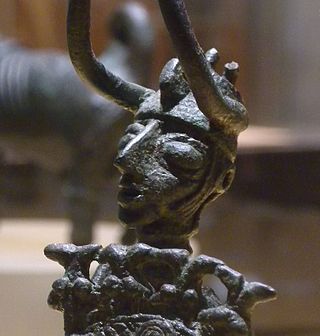
The Nuragic bronze statuettes are typical Nuragic Sardinian bronze sculptures of the final phase of the Bronze Age and the early Iron Age.
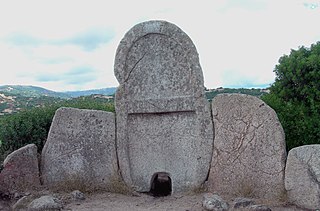
The giants' grave of S'Ena'e Thomes is a nuragic-era archaeological site located in the municipality of Dorgali, in the province of Nuoro, Sardinia.
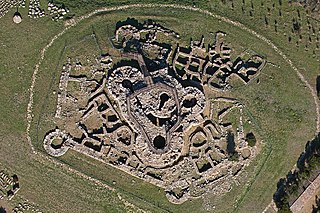
The nuraghe Genna Maria is an archaeological site in the comune of Villanovaforru, province of South Sardinia.

The Nuragic sanctuary of Santa Vittoria is an archaeological site located in the municipality of Serri, Sardinia – Italy. The name refers to the Romanesque style church built over a place of Roman worship which rises at the westernmost tip of the site. The Santa Vittoria site was frequented starting from the first phase of the Nuragic civilization corresponding to Middle Bronze Age. Subsequently, from the late Bronze Age to the early Iron Age, the place became one of the most important expressions of the Nuragic civilization and today it constitutes the most important Nuragic complex so far excavated.
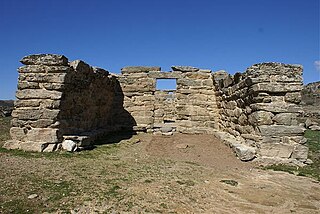
The megaron temple of Domu de Orgia is an important nuragic archaeological site located in the territory of Esterzili, in the Province of South Sardinia.

The nuragic sanctuary of Gremanu is a sacred nuragic area located in the territory of Fonni, in the province of Nuoro.
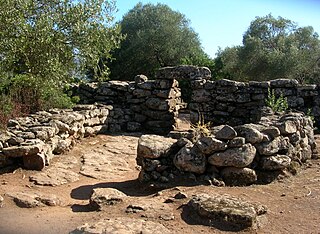
Serra Orrios is an important Nuragic archaeological complex located in the municipality of Dorgali, in the province of Nuoro.
Spazio Ilisso - Art Archives Museum is a Sardinian cultural promotion and enhancement center that integrates a museum with a permanent exhibition on 20th century and contemporary Sardinian sculpture, temporary exhibitions, digital archives and events.

The Menhir Museum, or Civic Archaeological Museum of the Menhir Statues, located in the Aymerich Palace in the village of Laconi, is a unique museum of its kind for its rich collection of steles found in the Laconi area, with the first discovery in 1969.

The Giorgio Asproni National Archaeological Museum is an archaeological museum in the historic centre of Nuoro, in Sardinia, near the Cathedral of Our Lady of the Snows. Established in 2002, it is located in a nineteenth-century building that belonged to Giorgio Asproni, a Sardinian politician and intellectual of that era.




















